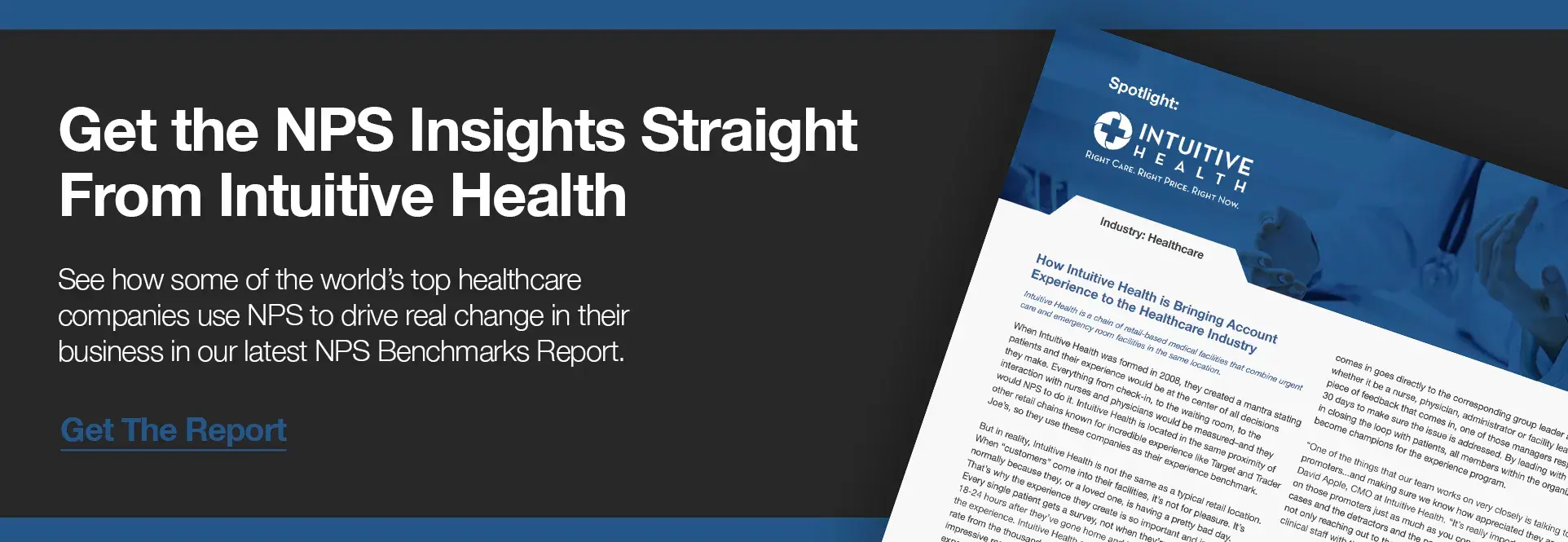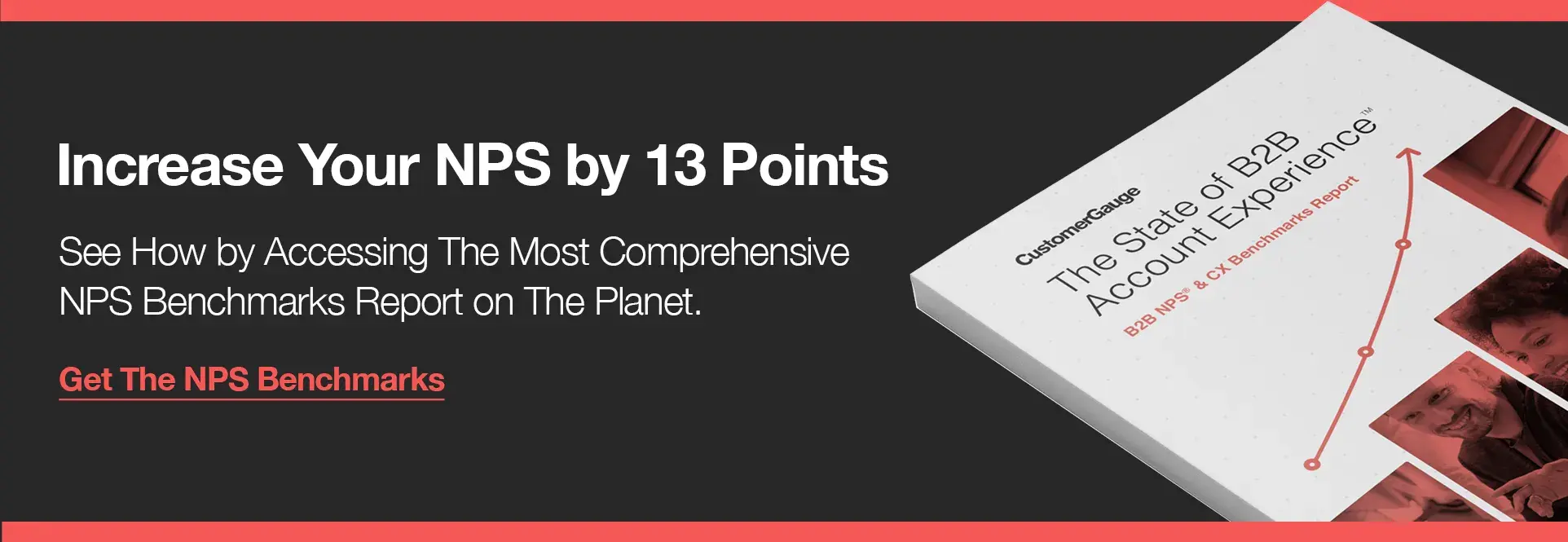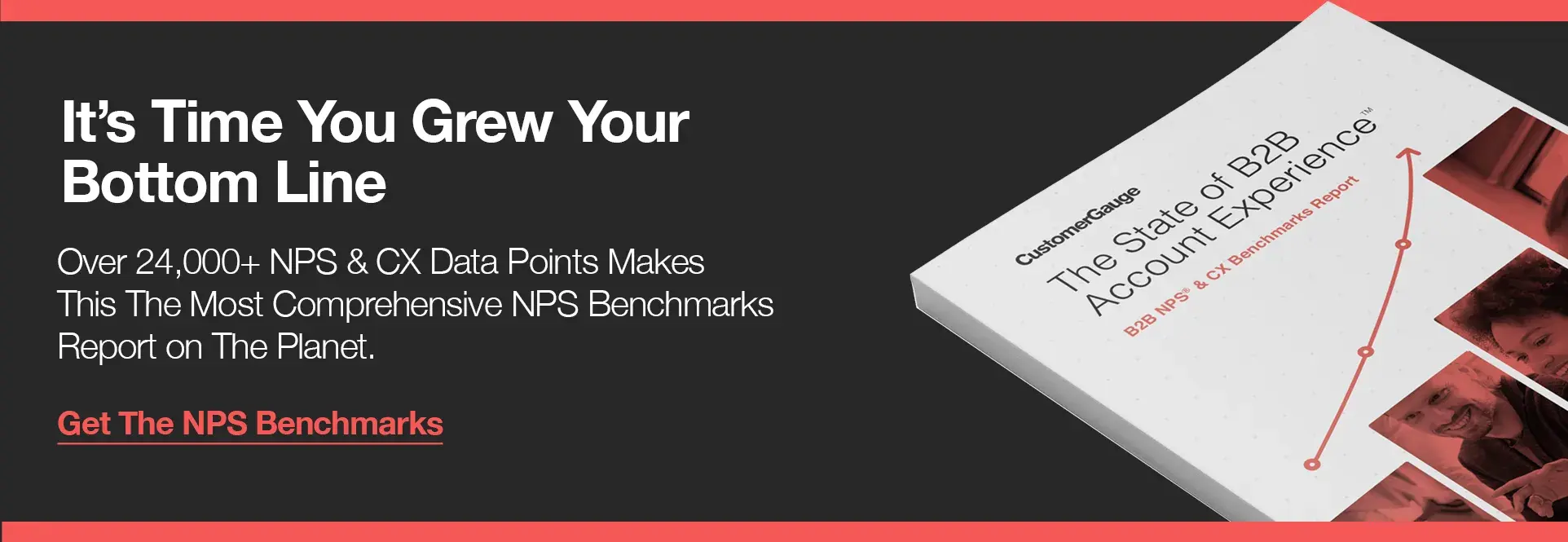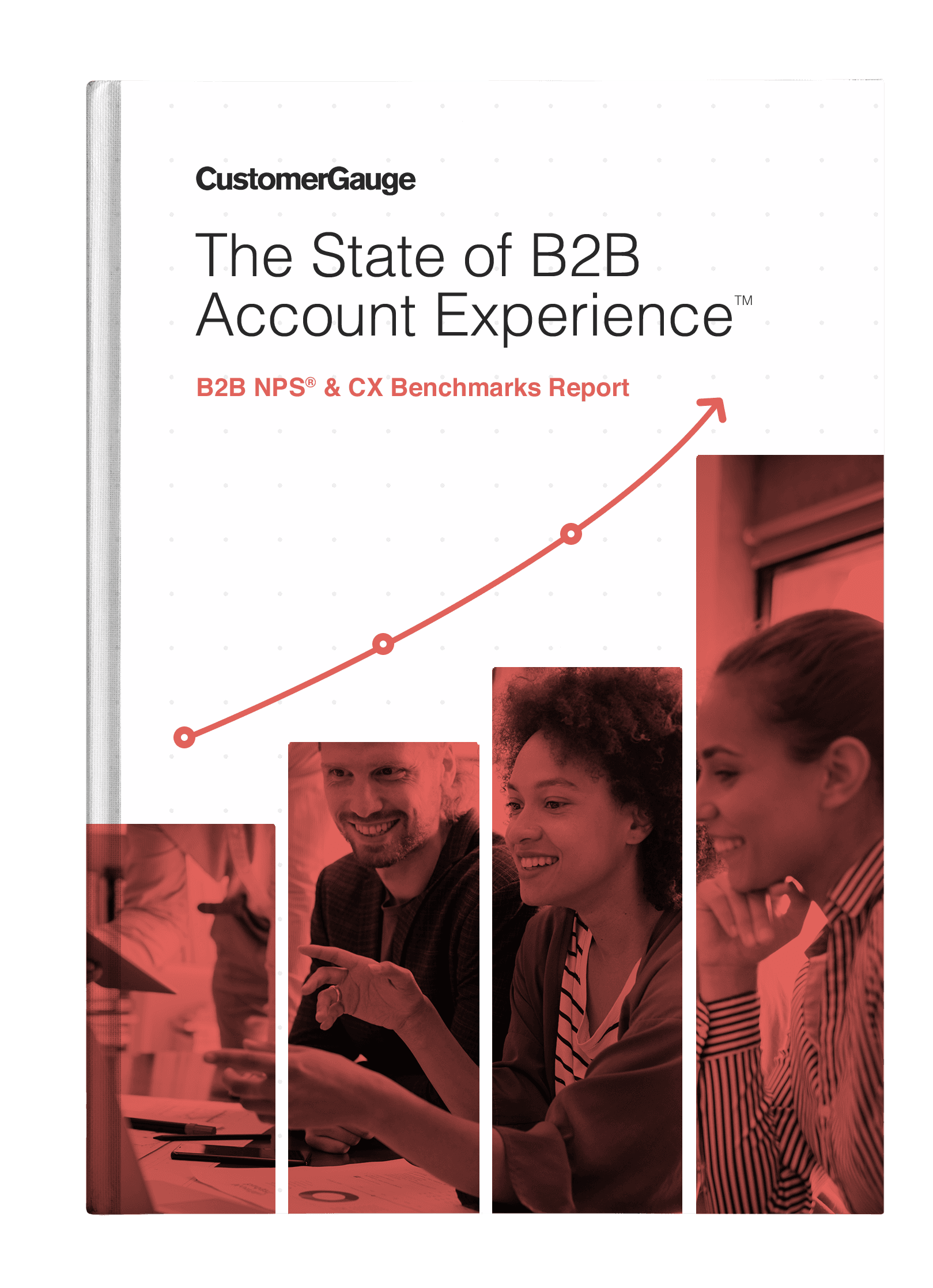NPS Healthcare Guide: 25 Healthcare NPS Benchmarks & Industry Guide
by Ian Luck
In healthcare, customer experience is much bigger than the company's bottom line, it's critical for patient wellbeing.
The impact of healthcare NPS drivers (e.g easy access to information, privacy, and a comforting and caring patient-doctor interaction) cannot be understated in their impact on patient loyalty.
Which makes the pursuit of customer referrals both logical and noble.
Your referrals are the ultimate test of sustained service value and patient care. They're also the number one indicator of company health and your future growth rate.
In this guide, we'll cover the essentials of NPS in the healthcare sector and how best to run your Net Promoter program. We'll also show you the result of our annual NPS Benchmarks survey, so you can compare yourself to industry averages and industry leaders.
We'll then take a look at how your NPS program can go one step further than loyalty research. We'll look how you can operationalize customer feedback in the same way Legacy ER did to transform the patient experience, reduce costs and grow loyalty faster.
Related case study: How Legacy ER & Urgent Care Used CustomerGauge to Transform Patient Experience

Table of contents
The essentials
- What is NPS in healthcare?
- Why is measuring loyalty important in healthcare?
- How to run an NPS survey the right way
- NPS survey best practices
- How to calculate NPS
- How to analyze NPS scores
- Tips for using NPS more effectively in a healthcare environment
NPS benchmarks
- What's the average net promoter score in healthcare?
- What's considered a good NPS score in healthcare?
- 25 healthcare NPS scores
- Deep dive: Three healthcare companies and their NPS programs
The future of NPS
What is a Promoter Score (NPS) in Healthcare?
Net Promoter Score's (NPS) are generated by surveys where respondents score a product or service on a rating scale of 1-10.
In the healthcare industry, NPS scores are used specifically to measure customer loyalty and satisfaction by determining how likely patients or subscribers are to recommend them to their friends.
Questions on healthcare NPS surveys are typically worded in a straightforward way to remove any confusion, misunderstanding, or bias.
Here’s the standard format of 'the' question:
“How likely are you to recommend [product, service, company name] to a friend or colleague?”
To make the most out of your NPS survey, this question is immediately followed by an open-ended request for more information, tapping into the deeper reasoning behind the initial rating.
Often, healthcare NPS surveys simply ask for an explanation for the rating, but alternative questions can be more specific.
Here are some examples of open-ended follow-up questions that regularly appear on healthcare net promoter score surveys:
Please provide a reason for your score?
What is the primary reason for your score?
How can we improve our service?
What did you like most/least about[product, service, company name]?
What features of [product, service, company name] did you value most/least?
Which of these features (x, y, z) contributed most to the score you gave?
In our Net Promoter Score course on the CustomerGauge Academy, we recommend using cascading questions in your surveys so your surveys appear short and manageable.
Why Is Measuring Loyalty Important In Healthcare, and How Can NPS Help?
Few people look forward to doctor or hospital visits, so being able to demonstrate you are a reputable company with an excellent rating goes a long way to alleviating patient stress. Also, when consumers choose a healthcare provider or product, they’re signing up for a consistent service rather than a one-off experience. So by leveraging an above-average net promoter score, healthcare companies can attract and retain customers more effectively.
Buying healthcare products and services is a more emotional purchase than most others because consumers are looking to protect the welfare of their own lives or that of their families or client base. So customer experience is key, especially in the wake of the COVID-19 pandemic. Research by SurveyMonkey reveals that 88 percent of healthcare executives think understanding patient experience is more important now than before the pandemic. NPS surveys in healthcare remain one of the best ways to measure that experience, while methodologies like AccountExperience ensure measured feedback results in real positive change for your company.
Our B2B NPS & CX Benchmarks Report identified that NPS still leads the pack as the most trusted metric to measure CX at 41%, with CSAT (Customer Satisfaction) further back at 26%, and CES (Customer Effort Score) a distant fourth at 11% (Listen to our podcast here on NPS vs. CSAT).
Customer experience is not just about research, though. Studies conducted by Harvard Business Review, Bain & Company, and CustomerGauge identify a strong correlation between high NPS scores and revenue.
By analyzing all the factors that contribute to your net promoter score, you can:
Pinpoint problem areas for improvement
Identify gaps in the market for new products and services
Reach out to supporters for reviews and referrals
Prevent customers switching to an alternative provider
Ensure partners and channel partners are engaged
Read more about our methodology for tackling churn and earning more referrals from your Net Promoter Program.
How to Run an NPS Survey and Collect Data in the Healthcare Environment
There are many different NPS software services you can use to design and run your surveys.
Before you get started or commit to a solution that may not be right for your company, we recommend you check out the full range of CustomerGauge NPS resources, including field guides, toolkits, eBooks, podcasts, webinars, and whitepapers. And check out our customer case studies to learn how companies like Coca-cola, Philips and Danone have built industry-leading NPS programs.
You then need to decide which type of NPS survey to run.
There are a lot of ways to send a NPS survey and deciding which channel to use can be daunting. The most common methods to send surveys include email, SMS, phone, website and in-app.
Once you’ve decided which approach to take, the steps to creating your survey are straightforward:
Create your survey using your chosen software
Give your survey a title that will attract customer attention and clicks
Add a description to encourage responses and help customers understand what you need
Compose a sign-off note thanking respondents for their time
Add your NPS question, and consider how long to make the entire survey
Consider your follow up questions and drivers
Determine your sample size
Activate the survey
Read these steps in-depth in our guide to NPS survey design.
When should you run an NPS survey?
Before we dive in, we have a full guide on best practice around 'when to send an NPS survey' here. We used our own customer data and discovered that NPS surveys should be run quarterly for the best results.
If you send a survey too soon before consumers have had a meaningful interaction with your service, they won’t be able to answer questions about satisfaction or whether they’d recommend you. Leave it too long, and their experience won’t be fresh in their memory. In either instance, your healthcare NPS benchmark will be inaccurate.
The best time to send your questionnaire depends on what type of survey you use. There are two types of NPS Healthcare survey:
Transactional survey - Following a particular event, like involvement in a new procedure, using a new piece of software, or a significant customer service interaction. Send out transactional surveys immediately to achieve the best response rate and most accurate scores.
Relationship survey - These measure overall customer satisfaction, and it’s generally agreed they should be sent somewhere between one week and a month after a customer signed up or first started using your services. You can track changes in satisfaction over time by sending follow-up surveys. Relationship NPS healthcare benchmarks are are a long-term measure of customer satisfaction, so many businesses send surveys bi-annually or quarterly. Bigger organizations with extensive customer databases may experiment with monthly feedback requests. However, for many companies, that would be overkill. After all, healthcare customers don’t appreciate being reminded of their medical needs too often.

Healthcare NPS Survey Best Practices
Creating an NPS survey from scratch may seem daunting, but it’s not as complicated as you might think. To get the best response rate and NPS score, healthcare companies should follow this list of NPS best practices.
Use Personalization
Personalization is essential in generating a reliable NPS healthcare benchmark because patients want to be seen as individuals, not as an extension of their medical needs. Your response rate will be higher if you greet patients by name and demonstrate a historical knowledge of their medical journey.
Consider Visual Elements
Customers can be just as easily turned off by how the survey looks as by a poorly worded question. To increase brand loyalty and recognition, it’s a good idea to customize your survey template to include brand assets like colors, logos, and fonts.
Send Reminders
Sending survey reminders is a guaranteed way to improve your response rate, especially with transactional surveys where you don’t want to wait too long to gather feedback.
Build a Continuous Feedback Loop
Add a tick-box requesting permission for further follow-up. You’ll get more in-depth feedback this way. Plus, it gives patients a voice and makes their opinion feel valued.
Test Internally
Never send out a survey before you’ve tested it internally first. This allows you to correct any errors and gather employee feedback about other potential issues and ideas for improvement. To gather the highest volume of reliable data, you need to ensure:
Your email engine is working
Emails open with the correct format and layout
Links to the survey work
The survey opens and runs smoothly across different browsers
Writing an Effective Questionnaire
Now you know the best practices to follow, let’s look at how to write the best healthcare industry NPS questions.
Survey Length
At CustomerGauge, our best NPS survey results are based on asking just three questions, and we’d advise against ever using more than four or five. If you make your survey too long, you’ll experience low response rates and inaccurate answers.
How to Phrase Questions
Minor changes to how you ask a question can significantly impact the quality of data you collect. Experiment with questions about service and product satisfaction over specific timeframes to gain a more accurate understanding of customer satisfaction. Take a look at these examples:
How likely is it that you would recommend [product, service, company name] to your friends and family?
Based on your experience with [product, service, company name], how likely are you to recommend us to your friends and family?
Now you’ve been using [product, service] for [length of time], how likely are you to recommend [company name] to your friends and family?
The approach used in question 3 would allow you to track changes in patient satisfaction much more accurately over time when conducting relationship surveys.
Add a Comment Box
This is a great way to demonstrate that your company cares about patient feedback beyond the scope of the survey. In our experience, around 44% of respondents will leave additional comments. Be sure to clarify that additional comments are optional, so respondents don’t get put off by the survey appearing too long.
Avoid Bad Writing Practices
Avoiding these common bad writing practices will help stop your survey from triggering spam filters:
Using all-caps or exclamation marks in the subject line
Using too many different fonts, font sizes, and text colors
Including buzz phrases like ‘act now’ or ‘last chance.’
How to Calculate NPS

Consumers that respond to your survey should be separated into three categories:
Promoters – Those who give ratings of 9 or 10
Passives – Those who give ratings of 7 or 8
Detractors – Those who give ratings of 0-6
To calculate your net promoter score, ignore the percentage of passive results and subtract the percentage of detractors from the percentage of promoters. This means your NPS Healthcare rating can range between -100 and +100. However, it’s unlikely your respondents will comprise solely of promoters or detractors, so somewhere in between is more likely. For example, if 60% are promoters and 20% are detractors, your net promoter score will be 40.
There is always some variation in statistics, but the average healthcare provider net promoter score is agreed to be around 38. However, it’s always good to keep an eye on your competition as well as the average healthcare NPS benchmark across the industry. Otherwise, you don’t know how much work is required to reach the upper echelons.
Net Promoter Score Scale: Promoters
Every health care business wants loyal patients who are happy to refer other clients, so the goal is to attract and retain as many promoters as possible. Promoters are drivers for growth and increased revenue, and as they are already satisfied customers, they are usually open to hearing from you more often.
Net Promoter Score Scale: Detractors
Detractors are dissatisfied customers, and dissatisfied customers are bad for business. NPS surveys identify unhappy customers early, allowing you to reach out and offer support before they slow your growth with negative word of mouth and online reviews.
Net Promoter Score Scale: Passives
Although passive responses are not included in the calculation of your healthcare net promoter score, identifying indifferent customers is an essential step in the process. If patients are on the fence about the quality of your services, they are more likely to leave you for a competitor or regress to a detractor in your next survey.
How to Analyze Net Promoter Score Results
The easiest way to calculate your NPS Healthcare score based on a 1-10 rating scale is to utilize our NPS calculator in Google Sheets.
For open-ended questions, the best tactics are:
Categorization - Tag feedback according to topic so you know which areas to focus on. Examples include customer service, waiting times, and affordability.
Demographics – For healthcare providers, much can be learned by separating responses into groups based on location, age, gender, income, etc. You can use this data to develop new processes and customize the patient journey.
Record Sentiments – You can identify potential shifts between promoter, detractor, and passive categories by recording comments as positive, negative, or neutral.
Measure Changes – Compare findings between surveys to determine whether the changes you implemented had a significant effect.
Tips for using NPS more Effectively in Healthcare
Promoters don’t just say the best things about your business. They actively reduce your overheads and increase your profits. A study by the University of Missouri found that:
The average promoter re-admission rate is 4.7% lower than for detractors
The average promoter emergency room return rate is 7.7% lower than that of detractors
The average care compliance is 14.2% higher in promoters than detractors
So, how can you use NPS results to turn more patients into promoters and gain more business? Here are some ideas:
Reach out to promoters directly to ask for friend and family referrals, online reviews, and shoutouts on social media.
Intervene quickly to turn detractor experiences around and convert them to passives or promoters in future surveys. This is an important process because research has shown that increasing customer retention rates by just 5% can lead to profit increases of between 25% and 95%.
To work towards a better net promoter score, healthcare providers should reach out to passive respondents to prevent them from becoming tempted by competitor offers. Impress them with superior customer service, earn their loyalty, and work towards your next NPS benchmark goal by turning them into a promoter.

What's the Average Net Promoter Score in Healthcare?
In our latest NPS Benchmarks Report, we discovered that the average NPS score for the healthcare industry is +58. Out of all the industries we analyze in our benchmarks report, healthcare came the highest, beating financial services by +14 points and SaaS NPS scores by +22 in 2021.
According to the American Hospital Association, hospitals lost $323.1 billion in 2020. Private healthcare providers suffered as well, with a significant decrease in patient appointments. Unfortunately, the industry is not expected to quickly bounce back. In 2021, 39% of hospitals are expected to be in the red (Kaufman Hall).
The silver lining is that the pandemic accelerated the digitalization of healthcare and changed the way many consumers take ownership of their health. Trends that were slowly taking root–such as tele-health appointments–quickly became critical pieces of healthcare in a remote world.
Faced with the threat of the coronavirus, many consumers shifted towards a more active role in caring for their own health. Looking to the future, healthcare providers should expect to adopt valuable new technologies and continue finding ways to meet and exceed patient expectations. Patients are also more selective and research-savvy than ever. According to Google, patients are 3X more likely to use search than non-search methods to find a hospital.
To set themselves apart from the competition, providers can create more personalized patient experiences through collecting and acting on feedback such as with the Net Promoter System.
Intuitive Health is an excellent example of this approach. Using CustomerGauge, they created a system for follow-up and feedback that helped them improve their patient experience, even through a global pandemic.
“Knowing how important promoters are to our business, we implemented improvements as issues arise,” said CMO of Intuitive Health, David Apple. “For example, if we see any consistent issues in billing, co-pay, or other procedures, we make changes in our operational process to improve based on that patient feedback.”
What's a good NPS score for healthcare companies?
Bain & Company (the creators of NPS) note that a good NPS score is 0 and above. Above 50 is excellent and above 80 is world class.
A score that's zero and above suggests that you have more Promoters than Detractors, which is a good sign. However, it's important to compare yourself to others in your industry.
In the healthcare industry, where the average score is +58, a score greater than 58 would be considered good, but our customers typically achieve +73. It should be your ultimate goal to match leading players in the industry.

Read more in our article ‘what is a good NPS score?’
Top healthcare NPS scores: 25 NPS Benchmarks for Healthcare Companies
Leading Healthcare NPS scores
Want to know NPS scores for all major players in the healthcare sector? Get the most comprehensive B2B NPS benchmarks guide on the planet here.
Three Healthcare Companies Using NPS
To gain a broader understanding of the importance of healthcare industry NPS scores, let’s look at how some of the leading providers use their surveys to improve customer loyalty and drive growth. You’ll notice the common denominator is the drive to improve the patient experience, not just the NPS score.
Clarify Health
Clarify Health’s NPS is 71%, significantly higher than the average healthcare provider net promoter score. The company is a trusted source of enterprise analytics for payers, providers, and life sciences organizations, and this is the fourth consecutive time they have exceeded the NPS healthcare benchmark. Client feedback identified these common themes behind their high ratings:
Ease of implementation and adoption
Exceptional customer service
Transparent data that creates trust among users
Legacy ER & Urgent Care
Legacy ER & Urgent Care always paid close attention to patient feedback, but they lacked the detailed processes needed for improvement and tracking until they adopted better NPS strategies. After implementing CustomerGuage, they found they could track and respond to patients in real-time and analyze satisfaction on a much grander scale.
Dig deeper into the case study: How Legacy ER & Urgent Care Used CustomerGauge to Transform Patient Experience
MedAvail
MedAvail has achieved an incredibly high NPS Healthcare score of 90, a staggering 52% higher than the industry average. This is attributed mainly to using NPS scores to determine what services customers find the most valuable and adapting to meet those needs. The development of their unique pharmacy model comprises live A/V connection, localized inventory replenishment, and access to refills on-site or by delivery, resulting in superior medication adherence and satisfaction. Plus, their high-tech pharmaceutical platform provides high value to all major stakeholders - the patients, the healthcare providers, and the payers.
Healthcare NPS Trends Over Time
Healthcare organizations must always look for ways to improve operations and care while increasing efficiency and value. We recommend downloading our NPS & CX Benchmarks Report for the most detailed analysis.
In the meantime, remember that however you manage your NPS, Healthcare companies must constantly respond to evolving healthcare trends to become or remain an industry leader. The biggest healthcare trends that companies should adapt towards in 2022 are as follows:
The continued presence of COVID-19.
Mental health and emotional wellbeing will be a focus.
Clinician burnout is likely to be an ongoing issue.
The development of innovative technology solutions to ensure healthcare equity will continue.
The emerging trend towards precision health and patient customization will grow.
Data from wearables like watches and fitness trackers will begin to play a more significant role in patient care.
Patients will have more options for care at home.
The development of digital healthcare models and AI healthcare tech will continue.
Health care systems will face the challenge of managing more data than ever before.
What it means to Monetize your NPS score
We promised we would get to it, and here we are: what it means to monetize your NPS score in healthcare.
Firstly, I recommend downloading our whitepaper eBook on AccountExperience. It’s this methodology that sets what we do at CustomerGauge apart from the rest, and it’s this methodology that has earned us the #1 ranking by Gartner for B2B voice of customer platforms.
The eBook will go into detail on anything mentioned here. In short, monetized net promoter is the process of operationalizing NPS survey feedback and scores so that you can:
Identify which of your accounts are about to churn. E.g. receiving advice like ‘based on your recent survey round $1.6m in revenue is indicated to be at-risk of churn. This includes your largest account with an ARR of $1m.’
Identify which of your accounts are willing to refer you. E.g. receiving advice like ‘your customer, XYZ Corp, has consistently given you a score of 9 or 10. It’s time to ask them for that referral.’
Identify which of your accounts are likely upsell opportunities. E.g receiving advice like ‘users at all levels of XYZ Corp’s organisation are extremely happy with your service. Your next review meeting is a good chance to focus on what’s next.’
A monetized net promoter score is the next step: operationalizing. Many companies measure NPS (and therefore run many surveys and collect tons of feedback) but fail to act upon it.
To act, you need to listen to each piece of feedback and take action upon it: either you talk to your unhappy customers, apologize and fix their issue, or you talk to your happy customers, celebrate together, and ask for referrals.
Account Experience is the methodology that helps you make the shift from ‘NPS is a research tool’ to ‘NPS is a growth driving tool’.

Frequently Asked Questions About NPS Benchmarks in Healthcare
1. What is a good Net Promoter Score in healthcare?
A good NPS in healthcare is typically above 50, indicating high patient satisfaction and loyalty. Scores above 70 are considered exceptional.
2. What is the average NPS in healthcare?
The average NPS in the healthcare industry generally ranges from 30 to 40, depending on the provider type and care setting.
3. What is the NPS benchmark for hospitals?
Hospitals usually report Net Promoter Scores in the 35 to 45 range, with top-performing institutions reaching 50+.
4. What is considered a high NPS in healthcare?
An NPS of 60 or higher is considered high in healthcare, reflecting strong patient advocacy and positive experience across touchpoints.
5. What is a bad NPS for healthcare providers?
An NPS below 0 indicates more detractors than promoters and suggests significant issues in patient care, communication, or access.
6. Which healthcare companies have the highest NPS?
Healthcare providers like Kaiser Permanente, Cleveland Clinic, and Mayo Clinic are often cited among top performers with NPS scores around 60–70.
7. What is Kaiser Permanente’s NPS?
Kaiser Permanente’s NPS typically ranges from 60 to 70, placing it among the highest-rated healthcare providers in the U.S.
8. How does Mayo Clinic perform on NPS?
Mayo Clinic is widely recognized for exceptional care and holds an NPS score typically around 70, among the highest in the healthcare sector.
9. What is a good NPS for private medical practices?
Private practices usually aim for NPS scores of 50 or above, with boutique or concierge providers sometimes exceeding 70.
10. What’s the NPS for urgent care centers?
Urgent care centers typically report NPS scores between 40 and 55, depending on wait times, provider communication, and location.
11. Why is Net Promoter Score important in healthcare?
NPS in healthcare helps providers measure patient satisfaction, improve care delivery, and track loyalty across multiple patient touchpoints.
12. How is NPS used in healthcare quality improvement?
Healthcare systems use NPS to identify pain points in the patient journey, improve clinical communication, and reduce churn or readmissions.
13. How does NPS impact patient retention?
Higher NPS scores correlate with increased patient loyalty and repeat care, especially in primary care and elective service environments.
14. What affects NPS in healthcare settings?
Key drivers of NPS in healthcare include provider communication, wait times, administrative ease, and empathy during care.
15. Can NPS be used to compare hospitals?
Yes, NPS is increasingly used alongside clinical outcomes and patient satisfaction surveys (like HCAHPS) to benchmark hospital performance.
16. What is a good NPS for telehealth services?
A good NPS for telehealth is above 50, with leading platforms reaching 60–70, driven by convenience and ease of access.
17. What is the average NPS for dental practices?
Dental practices generally report NPS scores between 50 and 70, depending on care quality, appointment scheduling, and follow-up.
18. What’s the benchmark NPS for health insurance companies?
Health insurers tend to have lower NPS scores, typically ranging from 10 to 30, due to pain points around claims and billing.
19. How can a clinic improve its NPS score?
Clinics can boost NPS by improving staff friendliness, streamlining appointments, offering follow-up communication, and minimizing delays.
20. Is NPS used in patient experience management?
Yes. NPS is a core part of patient experience programs, helping providers align clinical and operational improvements with loyalty metrics.
21. What’s the NPS benchmark for outpatient care?
Outpatient providers generally see NPS scores between 40 and 60, depending on specialty, wait times, and post-care communication.
22. How often should healthcare organizations measure NPS?
Healthcare providers should measure NPS after key visits or treatments and quarterly to track performance and trends.
23. What is the Net Promoter Score for pharmacy chains?
Pharmacy chains like CVS or Walgreens typically report NPS scores around 30–50, with top performers like GoodRx reaching 60+.
24. Can NPS predict patient churn?
Yes. A low NPS often correlates with higher patient churn, particularly in competitive care markets or private healthcare systems.
25. What’s the top quartile NPS in healthcare?
The top 25% of healthcare organizations report NPS scores of 60 or higher, indicating best-in-class performance.
26. Is NPS better than HCAHPS for patient feedback?
NPS complements HCAHPS by providing real-time feedback and loyalty insight, while HCAHPS focuses more on standardized satisfaction metrics.
27. Can you use NPS to evaluate healthcare technology vendors?
Yes. Hospitals and clinics increasingly use NPS to rate EMR systems, telehealth platforms, and health tech vendors for usability and support.
28. What is the global benchmark for healthcare NPS?
Globally, healthcare NPS benchmarks vary: U.S. averages are around 35–45, while countries with universal healthcare may score higher due to accessibility.
29. What’s the NPS for mental health providers?
Mental health providers tend to score between 40 and 60, with high empathy and personalization leading to higher loyalty scores.
30. What is a realistic NPS goal for a healthcare startup?
A realistic NPS goal for a new healthcare startup is 50 or higher, indicating strong early adoption and positive care experiences.
Blog Home








